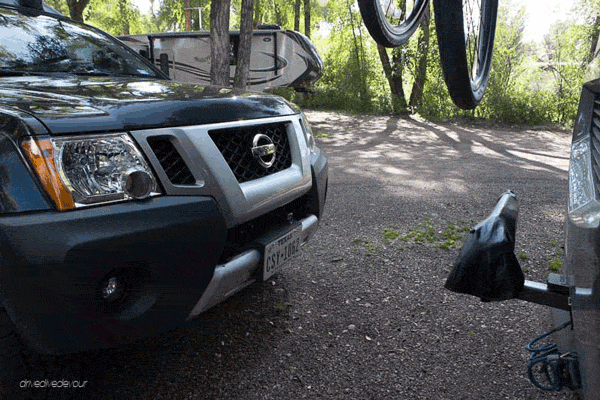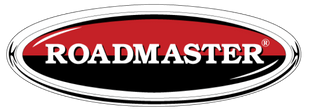There are four major components to any towing system:
- The Tow Bar
- The Baseplate
- Supplemental Brakes
- Accessories
Roadmaster offers a wide range of product choices within each category.

Our friends at Drive.Dive.Devour. outfitted their Xterra with Roadmaster products.
(Some of the terms below are unique to towing; others are unique to Roadmaster products. Our glossary of towing terms may be helpful).
Tow bar or tow dolly?
A tow bar is by far the most common method of towing. It allows for the quickest connection to the motorhome; plus, it's lightweight, easy to handle and simple to store.
(There is another way to tow: A tow dolly is ideal for those who want to tow multiple vehicles without having to install a baseplate on each one. Plus, a transmission lube pump system isn't necessary for front wheel drive vehicles with automatic transmissions, because the front wheels are off the ground).
1. Select the tow bar that's right for you...
(Before towing any vehicle, make certain that it can be towed with all four wheels on the ground, without damage to the transmission — refer to the owner's manual or the dealership. Most vehicles can be towed "as is"; some require aftermarket accessories such as a transmission lube pump system or a driveshaft disconnect. Both products are reliable, time-proven accessories that protect the vehicle's transmission during towing).
There are two basic tow bar designs: non-binding and classic. Most have "collapsible" arms which slide back and forth, making them easy to connect. Then, as you drive away, the arms automatically extend, self-center and lock in place. When not in use, both can be removed completely or folded against the vehicle for quick, compact storage.
Motorhome-mounted tow bars
insert into the motorhome hitch receiver, and can be stored on the back of the motorhome. Motorhome-mounted bars are preferred, because they never have to be lifted off the front of the towed vehicle, and you always have a built-in spot for storage on your motorhome. Or, they can be completely detached and lifted off the motorhome for long-term storage.
Car-mounted tow bars
are designed for simplicity and ease of use. They are mounted and stored on the front of the towed vehicle. They also can be completely detached and lifted off the vehicle for storage.
An economical alternative to collapsible tow bars is the "rigid A-frame" design. Because the arms do not adjust ("collapse"), the towed vehicle must be maneuvered into position, to align the tow bar to the hitch receiver on the motorhome. Rigid A-frame tow bars are simple, inexpensive and dependable; however, if you plan to connect and disconnect a towed vehicle frequently, a collapsible tow bar may be a better choice.
Every tow bar is rated at a specific weight capacity. Whichever tow bar you choose, it must be rated above the weight of your towed vehicle, plus its contents.
2. Connect to a baseplate...
Regardless of the type of tow bar you choose, a baseplate is required. Baseplates have one purpose: to connect the tow bar to the towed vehicle. Each baseplate is custom-designed to fit a specific vehicle or range of vehicles, and are attached to the frame, subframe, core support or other points along the vehicle's undercarriage.
Our friends at Drive.Dive.Devour. had their Roadmaster baseplate installed,
which sometimes involves the complete removal of the vehicle's fascia.
There are two types of baseplates: direct-connect and crossbar-style. Which one you will need depends upon the type of tow bar you will be using, and whether or not you are interested in using any of Roadmaster's protection and storage accessories.
Roadmaster manufactures more than 1,200 different tow bar baseplates, which fit more than 2,000 different vehicles; the baseplate search will tell you which style(s) are available for your vehicle.
3. A supplemental braking system...
At highway speeds, or during a panic stop, the inertia of a towed vehicle's weight may be too much for the motorhome's brakes to handle alone. ROADMASTER manufactures a "direct" supplemental braking system (BrakeMaster); a portable system (Even Brake) and a 'set-it-and-forget-it' system (InvisiBrake).
BrakeMaster and Even Brake are "proportional" systems — they work in relation to the motorhome's brakes; InvisiBrake applies a pre-set pressure to the towed vehicle's brakes.
Why do I need supplemental brakes?
Which system is right for me?
4. Safety equipment and accessories...
Safety cables are secondary safety devices, required by law in almost every state. Roadmaster manufactures two basic types: straight or coiled.
While in tow, every vehicle must be wired for functioning brake lights, turn signals and running lights. There are three ways to accomplish that: a system of diodes (the Universal Wiring Kit); a "bulb and socket kit" or magnetic lights.
Each method has its advantages. Whichever one you choose, Roadmaster has a kit with all the necessary components, and step-by-step instructions.
You will need an electrical cord to conduct the lighting signals from the motorhome to the towed vehicle. Flexo-Coil cords expand to more than eight feet and conveniently contract for storage; straight cords fit ROADMASTER All-Terrain tow bars.
These three items (plus other accessories) can be purchased separately, or you can purchase a Combo Kit, which contains the necessary accessories for your specific Roadmaster tow bar.

Our friends at Drive.Dive.Devour. put together this handy graphic and key showing their
completed baseplate and braking system installation on their Xterra, Rex.
1) Receiver for tow bar connections to drag Rex down the highway
2) Safety cable connection in case he tries to escape
3) Power plug to send power to the brake lights, turn signals, and brake [system] — This plug also sends the signal back to the motorhome dash LED.
4) Emergency brake away connection — In case Rex manages to escape, this pin will pull out and the brake [system] will apply the brakes to try to bring Rex to a stop before he hurts anybody. This is the last line of defense that we hope to never use.
